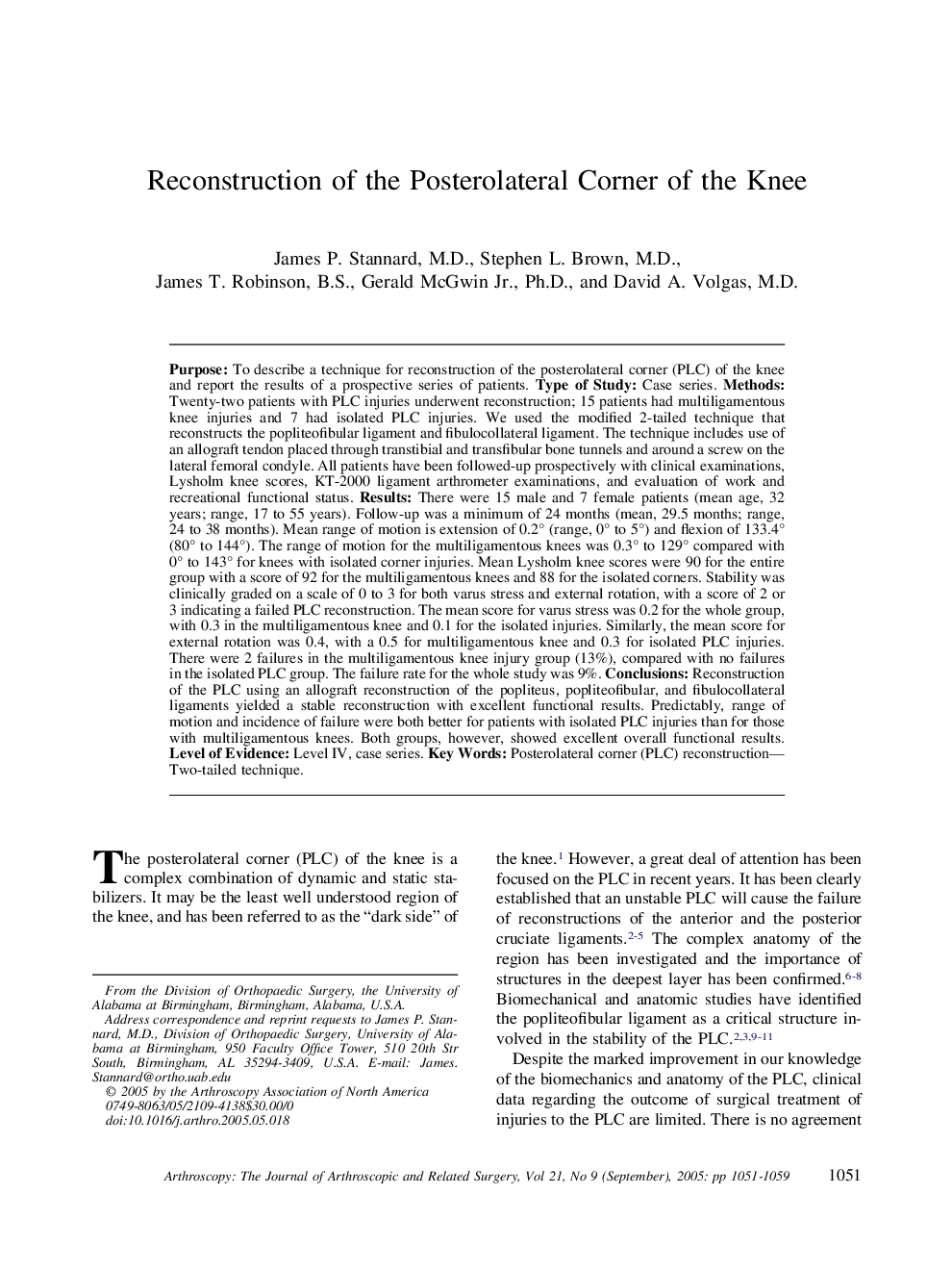| کد مقاله | کد نشریه | سال انتشار | مقاله انگلیسی | نسخه تمام متن |
|---|---|---|---|---|
| 10078860 | 1603619 | 2005 | 9 صفحه PDF | دانلود رایگان |
عنوان انگلیسی مقاله ISI
Reconstruction of the Posterolateral Corner of the Knee
دانلود مقاله + سفارش ترجمه
دانلود مقاله ISI انگلیسی
رایگان برای ایرانیان
موضوعات مرتبط
علوم پزشکی و سلامت
پزشکی و دندانپزشکی
ارتوپدی، پزشکی ورزشی و توانبخشی
پیش نمایش صفحه اول مقاله

چکیده انگلیسی
Purpose: To describe a technique for reconstruction of the posterolateral corner (PLC) of the knee and report the results of a prospective series of patients. Type of Study: Case series. Methods: Twenty-two patients with PLC injuries underwent reconstruction; 15 patients had multiligamentous knee injuries and 7 had isolated PLC injuries. We used the modified 2-tailed technique that reconstructs the popliteofibular ligament and fibulocollateral ligament. The technique includes use of an allograft tendon placed through transtibial and transfibular bone tunnels and around a screw on the lateral femoral condyle. All patients have been followed-up prospectively with clinical examinations, Lysholm knee scores, KT-2000 ligament arthrometer examinations, and evaluation of work and recreational functional status. Results: There were 15 male and 7 female patients (mean age, 32 years; range, 17 to 55 years). Follow-up was a minimum of 24 months (mean, 29.5 months; range, 24 to 38 months). Mean range of motion is extension of 0.2° (range, 0° to 5°) and flexion of 133.4° (80° to 144°). The range of motion for the multiligamentous knees was 0.3° to 129° compared with 0° to 143° for knees with isolated corner injuries. Mean Lysholm knee scores were 90 for the entire group with a score of 92 for the multiligamentous knees and 88 for the isolated corners. Stability was clinically graded on a scale of 0 to 3 for both varus stress and external rotation, with a score of 2 or 3 indicating a failed PLC reconstruction. The mean score for varus stress was 0.2 for the whole group, with 0.3 in the multiligamentous knee and 0.1 for the isolated injuries. Similarly, the mean score for external rotation was 0.4, with a 0.5 for multiligamentous knee and 0.3 for isolated PLC injuries. There were 2 failures in the multiligamentous knee injury group (13%), compared with no failures in the isolated PLC group. The failure rate for the whole study was 9%. Conclusions: Reconstruction of the PLC using an allograft reconstruction of the popliteus, popliteofibular, and fibulocollateral ligaments yielded a stable reconstruction with excellent functional results. Predictably, range of motion and incidence of failure were both better for patients with isolated PLC injuries than for those with multiligamentous knees. Both groups, however, showed excellent overall functional results. Level of Evidence: Level IV, case series.
ناشر
Database: Elsevier - ScienceDirect (ساینس دایرکت)
Journal: Arthroscopy: The Journal of Arthroscopic & Related Surgery - Volume 21, Issue 9, September 2005, Pages 1051-1059
Journal: Arthroscopy: The Journal of Arthroscopic & Related Surgery - Volume 21, Issue 9, September 2005, Pages 1051-1059
نویسندگان
James P. M.D., Stephen L. M.D., James T. B.S., Gerald Ph.D., David A. M.D.,